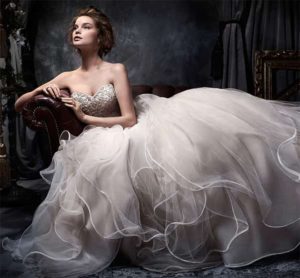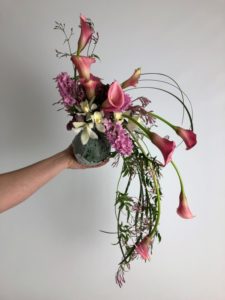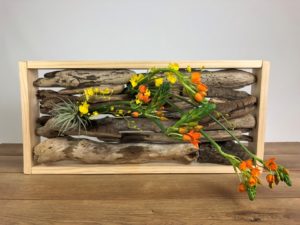The following is the second part of a three part journey of Karin’s Florist’s Director of Special Events and Creative Director, Bryan Swann EMC.
The second part was on my time. I was given a schedule of different arrangements I needed to design, analyze, take pictures of and post online for critique. I was also given a list of 650 Cut Flowers, Plants and Foliages that I needed to develop a sheet for 250 plants with the Botanical Name (genus and species), Family Name, origin, growth habit, usage, availability and care and handling.
The first assignment was to design a hand tied bouquet. Hand tied bouquets are created in the hand, bound in one place along the stems and need to stand on the stems without assistance. Here is what I designed:
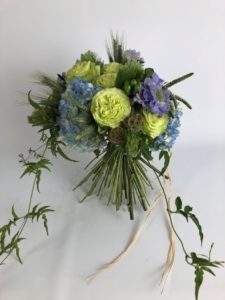 This self-standing bouquet consisted of blue hydrangea, green Lemonade roses, veronica, wheat, hypericum, scabiosa and Jasmine vines all bound together with raffia. I love the cool color combination of the greens and blues. And it stands!
This self-standing bouquet consisted of blue hydrangea, green Lemonade roses, veronica, wheat, hypericum, scabiosa and Jasmine vines all bound together with raffia. I love the cool color combination of the greens and blues. And it stands!
The second design we had to create was a zero-point design. This means that the stems of the flowers do not come together and all that the design should be concerned with is the placement of the flowers. I was inspired by Connie, a close friend that lives in Palm Springs, who has a fascination with Lenticular Clouds.
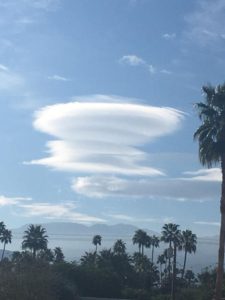
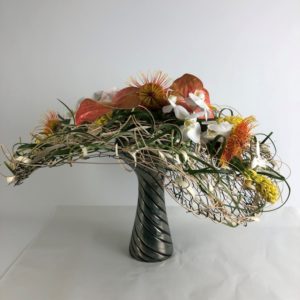 The picture of the clouds on the far right is one Connie took in Palm Springs and the photo to its left is my design. Wire was used for the form with woven grasses and reeds to support the anthurium, pin cushion proteas and orchid blossoms. To balance the arrangement, I used an upside down vase.
The picture of the clouds on the far right is one Connie took in Palm Springs and the photo to its left is my design. Wire was used for the form with woven grasses and reeds to support the anthurium, pin cushion proteas and orchid blossoms. To balance the arrangement, I used an upside down vase.
The third assignment was a wedding bouquet. I woke up in the middle of the night dreaming about the design below on the right. I had to get up, find a piece of paper and quickly draw what I saw in my mind. The image below on the left was of a regal bride I found on Google. She was the inspiration for my bouquet, along with the royal orb Kings and Queens carried at their coronation.
The bouquet is callas, jasmine, hyacinth and orchids emerging from a dusty miller covered sphere for her to carry. I used the traditional Hogarth Curve as the line in the bouquet updating a traditional design.
The fourth assignment was Designer’s Choice. I drew the idea from my youth growing up on the shores of the Potomac River in Southern Maryland. I remember my grandmother taking me and my brothers to the shore to gather shark’s teeth, beach glass and drift wood. As homage to her, I built this design out of the Potomac River driftwood interlaced with ornithogalum and oncidium.
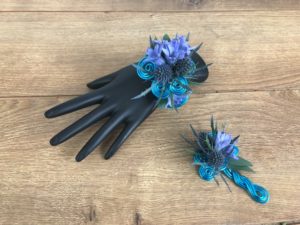 The fifth assignment was to create a corsage and boutonnière. I imagined a young, artistic couple headed to prom. I wanted to create something fun and vibrant with some new materials thought about in a new way. I started with turquoise aluminum wire and braided it, then finished off the ends by spiraling the wire back on itself. The eryngium, hyacinths and eucalyptus finish off the design.
The fifth assignment was to create a corsage and boutonnière. I imagined a young, artistic couple headed to prom. I wanted to create something fun and vibrant with some new materials thought about in a new way. I started with turquoise aluminum wire and braided it, then finished off the ends by spiraling the wire back on itself. The eryngium, hyacinths and eucalyptus finish off the design.
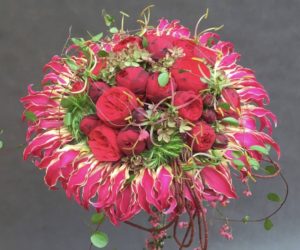 The final design assignment was to analyze a design by another designer. I chose a hand tied bouquet by Gregor Lersch. Gregor is a German floral designer that I have been following for many years. I had the opportunity to take a workshop with him a few years ago and loved every minute of it. I love the vibrant color harmony in this design. His deconstruction and reconstruction of the gloriosa lilies is awe inspiring.
The final design assignment was to analyze a design by another designer. I chose a hand tied bouquet by Gregor Lersch. Gregor is a German floral designer that I have been following for many years. I had the opportunity to take a workshop with him a few years ago and loved every minute of it. I love the vibrant color harmony in this design. His deconstruction and reconstruction of the gloriosa lilies is awe inspiring.
After getting these six assignments finished and submitting the 250 plants for the nomenclature assignment, I was done with Part 2. I learned so much more about the plants and materials we use in the floral industry. I was able to stretch my abilities and try different techniques. I passed everything satisfactorily and was invited to move on to Part 3.
The next blog will be Part 3 – Advanced – Emotional Expression Knowledge

